When it comes to drinkware of the Viking era, popular media has made it seem like they only had a couple of options. Most popular of which being horns, or of course the ever gruesome… human skulls. But the question is, how much of this is based on documented evidence??
Table of Contents
Did Vikings drink from the skulls of their enemies?
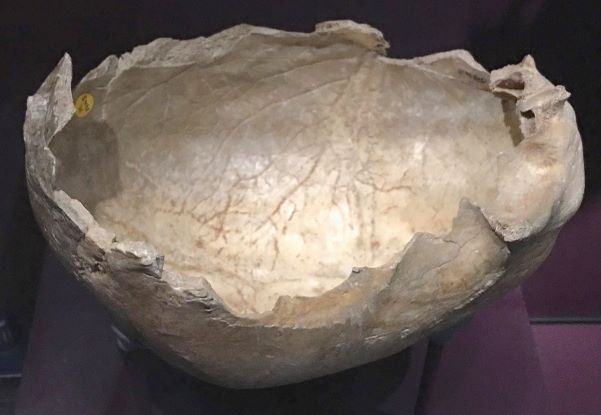
The spread of false information has led some to believe that the Vikings drank from the skulls of their enemies. However, there is no documented evidence of this other than mythological writings such as Völundarkviða, part of the Poetic Edda.
Völundarkviða, also known as ‘the lay of Völund’ in old Norse. Tells the tale of Völndr, a talented blacksmith, and his escape from his island imprisonment where he is forced to forge items for his captor, King Niðad of Närke. Who after hearing of Völundrs talents had him kidnapped and hamstrung rendering him unable to walk.
To enact revenge for this Völundr Lures the king’s two sons to his island where he cuts off their heads, sets them in silver, and gifts them as cups to the king. while as their eyes and teeth he turns to glimmering gems for Niðad’s wife and daughter.
“ Come ye two alone,
Tomorrow come! And the gold shall be given to you, tell it not to the maidens, nor to the hall men, nor to anyone, that you have been to see me.
Early called one the other, brother, brother. let us go see the rings! to the chest they came, for the rings they asked, when within they looked
Of those children the heads he cut off the feet he throws into the forge-fire but their skulls beneath the hair he set in silver and to Niðad gave.
And of their eyes glimmering rocks he sent to the wise Wife of Niðad of the teeth he then made breast ornament and to Bodvild sent.
Go to the Smithy which you had built. there will you find the Bellows blood besprinkled. Under the bellows their bodies laid.”
Völundarkviða, part of the Poetic Edda.
Another thing that has helped this theory grow is that the Scandinavian word for cheers “skål” sounds much like the English word “skull” but this also is just a misunderstanding. because the word skål derives from the Norse word skál which means bowl, while the Norse word for skull is skalli
All in all an interesting concept, yes. but definitely not factual.
Drinking horns?
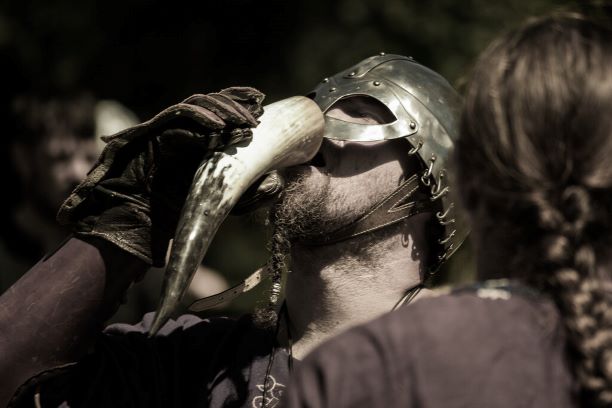
One of The preferred drinking vessels of wealthier people in the Viking era was haloed out cattle and goat horns. Drinking horns have been depicted in stone etchings across Scandinavia as well as the rest of Europe. And fittings for horns were found at the Sutton Hoo burial site. Though Actual horn fragments of the Viking age are only rarely preserved.
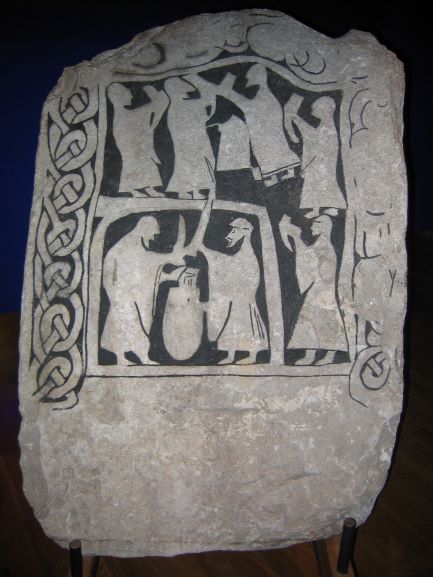
Drinking horns are also mentioned in Beowulf and the Poetic Edda.
Lokrur, An Icelandic mythological Poem dating back to c. 1400 tells of the journey of the god Thor to Útgarða-Loki.
In which at one point Thor challenged anyone willing to compete in a drinking contest, but gives up after noticing that no matter how much he drinks no liquid seems to drain from the horn.
Only to find out later when Útgarða-Loki informs him the reason for this being that the far end of the horn from which he drank from was connected to the sea, and that he had actually drunk so mush he lowered the ocean level, resulting in the tides. And that they even began worrying he might drink so much he would drain it completely!
In typical Viking life, drinking horns were definitely a symbol of wealth for some, being something that they would be seen caring around with them during feasts and get together‘s. Customized horns would help show others their societal status, the more unique and eye-catching the better.
Though due to horns being pretty easy to attain throughout Scandinavia, this type of drinkware would have not only been owned and used by the wealthy, even the average citizen would have probably owned one. It would have just been a bit less flashy version. Sometimes custom ordinate horns were given as gifts from the nobles to their villagers.
You may be wondering, seeing as the horn is curved at the end, how they set it down without spilling. Well for one the Germanic people did have a custom to drink the entirety of the cup full before setting it back down, or “bottoms up” if you will.
Though some horns did have metal legs and or stands and some horns had the curved end cut off altogether leaving them flat on the bottom. Some even having Handles attached.
Glass cone Beakers
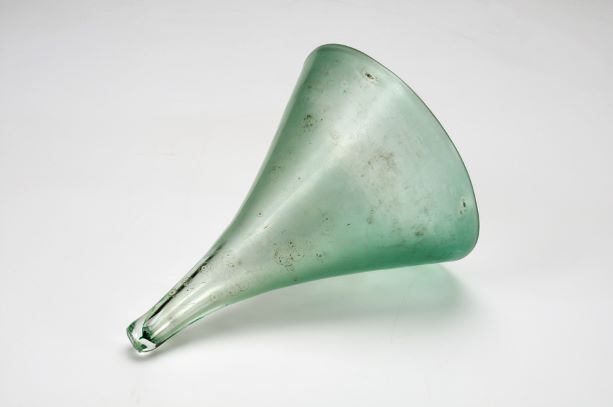
Possibly even more luxurious than drinking horns, cone beakers were most certainly an item used mainly by those of higher social status because while the Viking age Norse were skilled in the art of glass making and did produce not only cone beakers but also glass bowls and most popularly ordinate glass beads.
How readily available such items were would have depended on what area you were in. Because whereas some villages focused more on the production of glass others would have focused on the trade of imported glass brought back to Scandinavia after raiding\trading missions. And this style of conical glassware Most likely came from Francia where it is believed they were first produced.
Cone beakers of various sizes have been found in Birka, Sweden, and Trelleborg, Denmark. During archaeological digs Though only about a dozen have been found and were mainly found in the graves of women.
Precious metals

One of the many talents belonging to the Vikings was the art of blacksmithing whether the material is iron, steel, copper, bronze, pewter, silver, or gold. We have many examples of beautiful Viking-aged swords, helmets, chainmail, jewelry, and a plethora of other items including the occasional cup.
While they tended to focus mainly on weaponry and Jewelry, we have found metal cups dating back to the period and are believed to have been made by the Viking-aged Norse because of the unique design patterns used. For instance, some have depictions of animals or beasts with serpent-like bodies intertwined with one another.
The jelling silver cup, for example, which dates to 953 CE, was found in the 19th century during the excavation of a burial mound belonging to king Grom the old (c. 936-953 CE) in jelling, Denmark.
Back to basics
Now of course it needs to be noted that the Viking life could often be pretty rough and not everyone could afford to have luxury drink wear. The majority of people were probably more worried about HAVING something to drink versus what they were drinking it out of.
So more than likely anything that could hold liquid would have been used as a cup. In fact, simple cups made of wood and other organic materials were one the most common to see both on tables of the elite as well as the working class due to the materials being easy to source and easy to work with. Though this also means such cups are rarely found today Because those materials are so prone to decomposition.
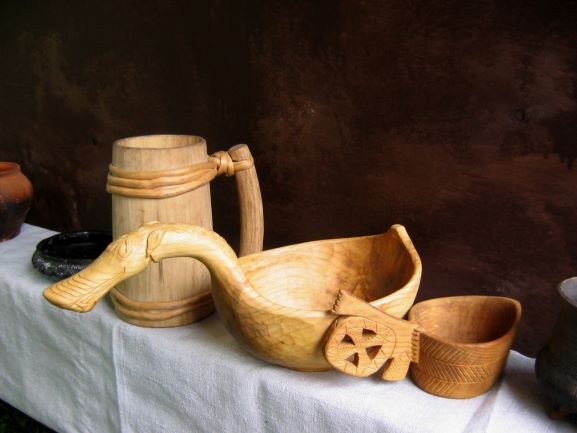
Conclusion
In summary, Vikings didn’t drink from the skulls of their enemies, and it’s not all just drinking horns as the media portrays. However, they did drink from conical glasses, precious metals, horns, and wooden/ceramic cups.
The Norsemen were way more advanced than most give them credit for and they had plenty of options to choose from when it came to how they consumed their drink of choice.
And if your next question is What was their drink of choice?? Then good news! you can read all about it here!
